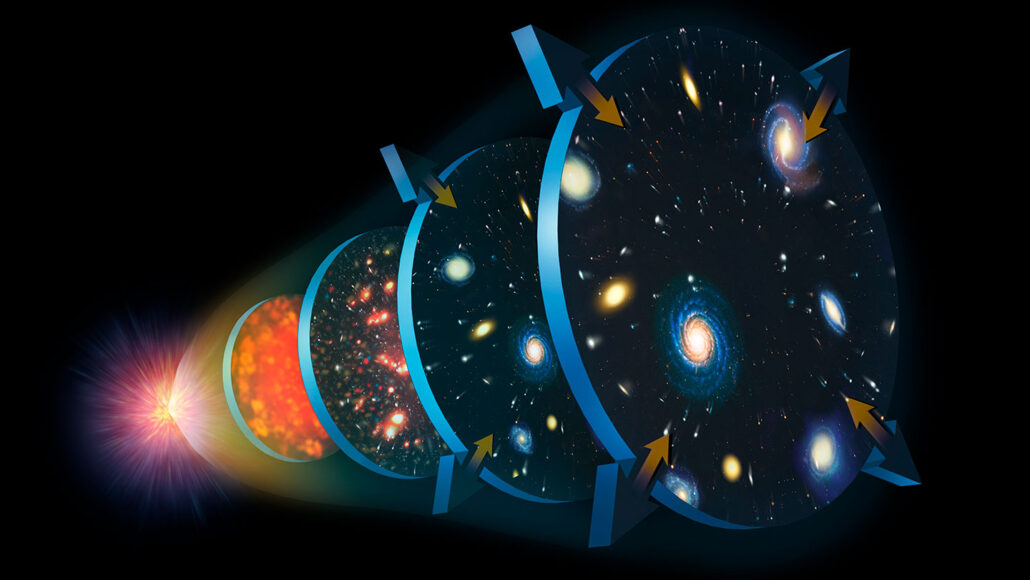Mysteries about the universe abound, from its beginning to its end
The early cosmos started out lawless. Even now, scientists struggle to understand what they see

This illustration imagines slices of our universe through time — from the Big Bang (left) to now (right). Over that time, everything has expanded and a whole host of new things have developed, including what we now think of as the fundamental laws of physics. Those laws govern space, time and energy.
Mark Garlick/Science Photo Library/Getty Images Plus
By Trisha Muro
All matter and energy in our cosmos appear to be governed by fundamental laws of physics. These rules hold from the tiniest, subatomic scale through the vast expanse of space. But that wasn’t always true. The earliest eras in cosmic history were both fleetingly short — and surprisingly lawless.
The law of gravity came first. Physics suggests that about 10-43 second after the Big Bang, gravity emerged as its own distinct force. A fraction of a second later, the strong force came into its own. (That force would someday hold together particles like protons and neutrons.)
At this point, the universe would still be unrecognizable to us. Light did not yet exist. Nor did matter. There were none of the building blocks needed to form atoms and molecules. They would come later. But this period was active. In a tiny fraction of this first second, the cosmos would grow some 100 million billion billion-fold. Whew!
Soon the weak nuclear force took hold, governing the complex ways matter and energy would eventually interact. Finally, the electromagnetic force emerged. This lay the final groundwork for charged particles and magnetism. Particles called bosons “carry” these forces. Eventually, this first, stunningly active second of cosmic history drew to an end.
Within the next few seconds, subatomic particles began to form. Then matter and energy became distinct. Governing their interactions were those new four forces of physics.
Four forces governing the whole universe might sound simple. But there is still so much about the nature of our universe that scientists don’t know. How forces governed the earliest universe, for instance. Or what the universe’s ultimate fate will be. Even whether our universe is the only one out there. But cosmologists are coming up with some creative answers.

Educators and Parents, Sign Up for The Cheat Sheet
Weekly updates to help you use Science News Explores in the learning environment
Thank you for signing up!
There was a problem signing you up.
Quantum gravity
Quantum mechanics are the laws of physics that mainly describe how things work at the subatomic scale — that is, when talking about things smaller than atoms. General relativity explains how gravity governs interactions between larger structures in the universe. Such “large” structures range from black holes and galaxies to people and grains of sand.
Both quantum mechanics and general relativity work extremely well within their own scales. But sometimes, scientists want to bridge the two. For instance, when talking about huge amounts of mass and energy packed into a very tiny space. This can come up when scientists try to describe how the universe evolved in its first few moments after the Big Bang, as everything was bursting into existence. Indeed, strange things happen when researchers try to mix laws of quantum mechanics and relativity.
Here’s the problem. Quantum mechanics says that subatomic particles sometimes act like waves and at other times as particles. There’s probability — chance — involved in how they interact.
Yet laws that describe matter on a larger scale, such as relativity, reject that notion of probability. In this realm of physics, it is possible to predict exactly how matter will behave based on physical laws. Those predictions are reliable and repeatable. They leave nothing to chance.
So, when physicists have to find a way to combine the chance-like nature of quantum mechanics with the certainty of relativity, the math to explain what’s happening starts to fall apart. Answers to that math become nonsense.
It’s possible to distinguish which set of rules applies where — big objects governed by relativity and small ones by quantum mechanics — back to a tiny fraction of a second after the Big Bang. To describe matter before that, a new theory will be needed. That new theory, known as quantum gravity, will hopefully unite quantum mechanics and general relativity.
“There are very, very, very, very few scenarios where you need a theory of quantum gravity,” notes Adrienne Erickcek. “That’s good, because we don’t have one!” Erickcek is an astronomer at the University of North Carolina at Chapel Hill.
“There are extremely few scenarios when you have enough mass for gravity to be important in a small enough space that quantum mechanics is important,” Erickcek explains. “But the Big Bang is the one where we need it!”
Which universe are we?
Having no theory to explain quantum gravity has not stopped scientists from trying to imagine how things might have evolved shortly after the Big Bang. Here are a couple of the possibilities.
A universe of bubbles: Inflation is the name for when the universe explosively expanded in that first second after the Big Bang. One idea for why that happened is that our universe is one inflating bubble in a foam of expanding bubble universes.
If the universe is just one bubble among many, that might help solve another cosmic mystery: Why are the laws of physics the way they are? Why are fundamental forces, like gravity, as strong as they are? Why do different particles, like protons, weigh as much as they do?
If our universe is just one bubble, and there are more bubbles beyond ours, then each bubble might have its own laws of physics. Our universe might have the physics it does simply because of the way our bubble was set up in the beginning. It could have just as easily evolved with totally different physics, as other bubbles did.

A universe of strings: Inside any piece of matter is a vast number of atoms. Inside each atom is a collection of subatomic particles. Those include protons and neutrons. Making up those particles are quarks.
String theory suggests tiny, one-dimensional “strings” exist inside quarks. These strings can vibrate at different frequencies. This is similar to the way a plucked guitar string can generate different notes.
Eva Silverstein is a physicist who works at the Stanford Institute for Theoretical Physics in California. She says that the exciting thing about string theory is that it might unite matter and energy at both the smallest (quantum) scales as well as the largest (general relativity) scales. String theory might someday explain how the Big Bang caused many of our fundamental laws of physics to develop as they did.
The fate of the universe
The Big Bang describes what likely happened in the earliest history of our universe. Today, the universe is still expanding. But how might its rate of expansion differ far in the future?
For a while, scientists thought the universe might eventually stop expanding. They thought the gravitational pull of all the mass in the cosmos might cause the universe to collapse back in on itself. (This would be similar to a baseball tossed in the air, only to quickly fall back down.) Such a Big Crunch might even give off enough energy to spark another Big Bang. This theory has sometimes been called the “oscillating universe.”
But recent data suggest this is not the fate of our universe. Observations have begun to tip the scales toward an ever-accelerating universe. In this case, it’s as if the ball you threw into the air not only keeps going higher, but keeps getting faster as it does so.
This seems to resolve the issue of whether cosmic expansion will end. At the same time, scientists can’t quite explain why the universe’s expansion is speeding up.
For now, scientists try to explain what they’re seeing with an idea called dark energy. It’s believed to make up nearly seven-tenths of the universe.
Scientists can see what it does. Telescope observations show galaxies flying away from one another at ever faster speeds as they grow more distant. But just what dark energy is also remains a mystery.
One thing about dark energy is clear. Its existence makes an oscillating universe impossible. But pretty much everything else about this mysterious phenomenon remains unknown.
The universe is nearly 14 billion years old. Humankind has only peered at it through telescopes for the last 400 years. We have a long way to go as we seek to explain how the cosmos works. But just like the universe’s own incredible growth, people have come a long way in a very short time.







